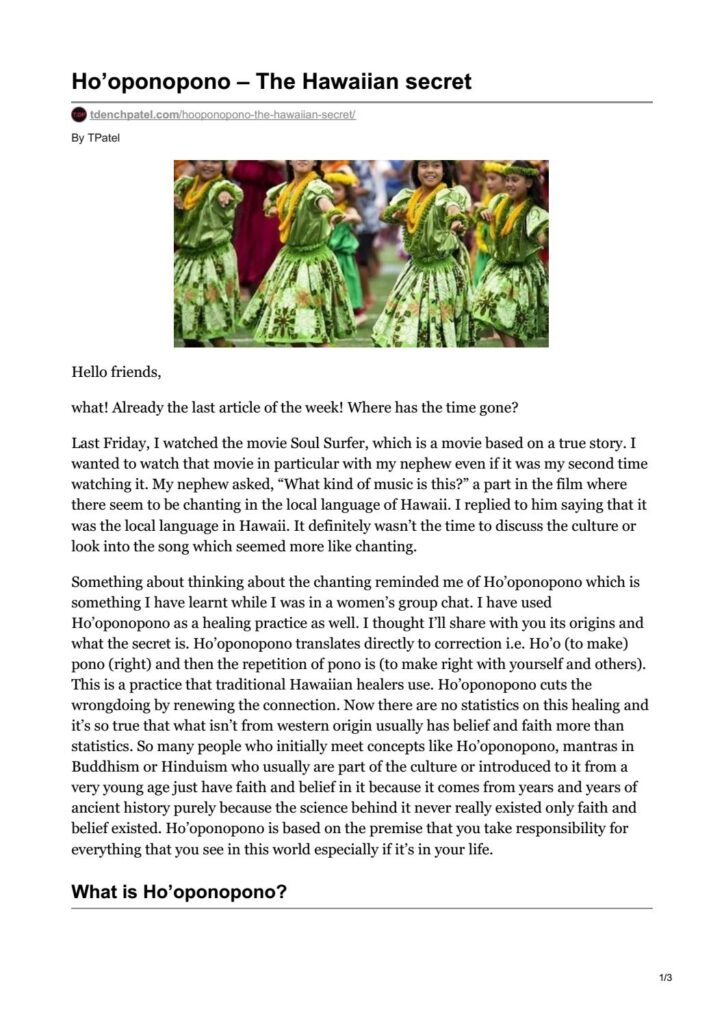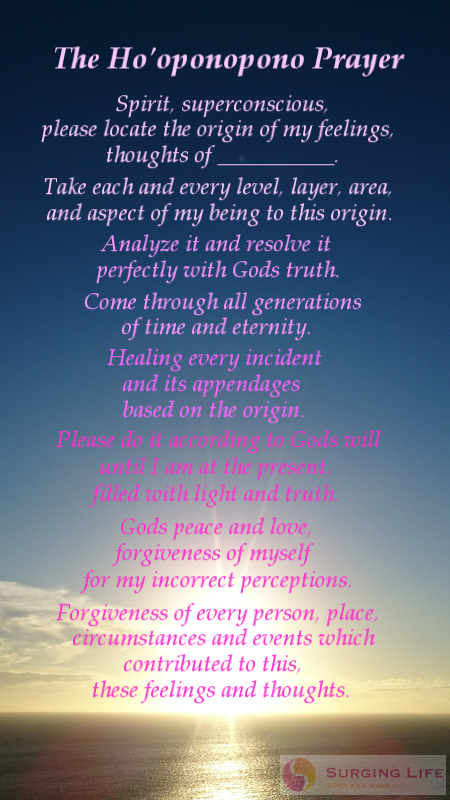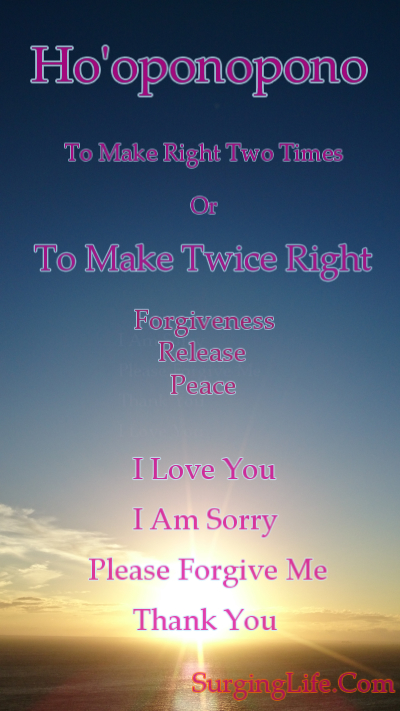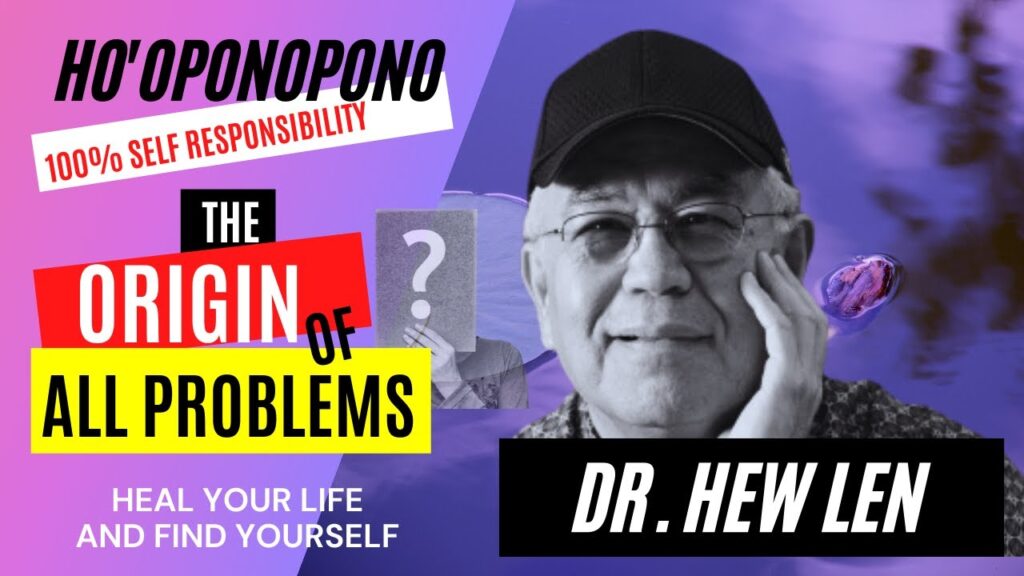So, have you ever heard of this thing called Ho’oponopono? It’s a pretty interesting concept, and it has its roots in the beautiful culture of Hawaii. Basically, Ho’oponopono is a traditional Hawaiian practice of reconciliation and forgiveness. It’s all about restoring harmony and balance in relationships, whether it’s with yourself or with others.
You might be wondering how exactly this practice came about. Well, Ho’oponopono has been passed down through generations in Hawaiian families. It was traditionally used as a way to resolve conflicts within a community or a family. The word “Ho’oponopono” itself means “to make right” or “to correct,” which gives you a pretty good idea of what it’s all about.
In the coming paragraphs, we’ll dive deeper into the principles and techniques of Ho’oponopono and explore how it can be applied in our modern lives. Whether you’re interested in improving your relationships, finding inner peace, or simply learning about different cultural practices, there’s a lot to discover about Ho’oponopono. So, let’s explore this fascinating practice together and see how it can bring positive change into our lives.

Ancient Hawaiian Practice
Ho’oponopono, often referred to simply as Ho’oponopono, is an ancient Hawaiian practice deeply rooted in the culture and traditions of the Hawaiian people. This traditional ceremony holds great significance in Hawaiian society, as it is considered a method of reconciliation and forgiveness, aiming to restore harmony and balance within individuals, relationships, and communities.
Roots in Hawaiian Culture
Ho’oponopono is believed to have originated in the ancient Polynesian cultures and was later embraced and developed by the Hawaiian people. It is deeply connected to the core principles of Hawaiian spirituality and beliefs, which prioritize the connection between humans, their ancestors, and the divine.
In Hawaiian culture, the concept of ‘ohana, meaning family, extends beyond immediate blood ties to encompass the wider community. It is the responsibility of each individual to maintain and restore harmony within the ‘ohana, and Ho’oponopono serves as a means to achieve this.
Traditional Ceremony
Traditionally, Ho’oponopono was conducted in a formal ceremony led by a respected elder, who acted as a mediator between the individuals involved in a conflict or dispute. The ceremony would usually take place in a sacred space, such as a heiau (a Hawaiian temple) or the home of the elder.
Participants would gather together to engage in a structured process of communication, reflection, and forgiveness, guided by the elder. This process involved expressing grievances, apologizing, and seeking forgiveness from each other. It also revolved around the belief that by acknowledging and taking responsibility for one’s actions, healing and resolution could be achieved.
Meaning of Ho’oponopono
The word Ho’oponopono itself carries profound meaning within the Hawaiian language. It is often translated as “to put things right” or “to rectify an error.” However, its true essence goes beyond these literal translations. Ho’oponopono is a holistic practice that encompasses the mind, body, and spirit, aiming to bring about a state of balance and alignment.
A Method of Reconciliation and Forgiveness
The primary purpose of Ho’oponopono is to restore harmony and balance within individuals, relationships, and communities. It serves as a method of reconciliation and forgiveness, allowing for the resolution of conflicts and the healing of emotional wounds.
Restoring Harmony and Balance
In Hawaiian belief, disharmony within an individual or a relationship is seen as a reflection of imbalance in the larger universe. Ho’oponopono seeks to address this imbalance and restore harmony by recognizing and rectifying the root causes of conflict or discord.
Through open and honest communication, individuals engage in a process of self-reflection and taking responsibility for their actions. This process allows for the release of negative emotions, the healing of past wounds, and the restoration of balance within oneself and with others.
Resolving Conflict and Disputes
Ho’oponopono is often employed in resolving conflicts and disputes within families, communities, and even between nations. It provides a platform for individuals to express their grievances, listen to others’ perspectives, and seek forgiveness in a safe and controlled environment.
This process of open dialogue and shared responsibility allows for the resolution of long-standing conflicts and the cultivation of understanding and empathy. By fostering a sense of unity and connection, Ho’oponopono paves the way for healing and reconciliation.
Healing Relationships
At its core, Ho’oponopono is a practice of healing relationships. It seeks to mend the broken bonds between individuals, restoring trust, love, and respect. By acknowledging past hurts, expressing remorse, and seeking forgiveness, Ho’oponopono promotes emotional healing and strengthens the foundation of relationships.
Through this process, individuals are able to release negative emotions, let go of grudges, and cultivate a sense of compassion and understanding. By embracing Ho’oponopono, individuals are empowered to develop healthier and more fulfilling connections with others.
Influence of Spirituality and Beliefs
Ho’oponopono is deeply intertwined with Hawaiian spirituality and beliefs. It is grounded in the notion of interconnectedness and the belief in the collective responsibility for maintaining harmony and balance.
Connection to Hawaiian Ancestors
In Hawaiian culture, ancestors hold a significant place of reverence and are considered a source of guidance and wisdom. Ho’oponopono acknowledges the presence and influence of ancestral spirits and seeks their assistance in the healing process.
Participants in Ho’oponopono ceremonies often invoke the mana (spiritual power) of their ancestors, seeking their guidance and support in resolving conflicts and restoring harmony. This connection to ancestral wisdom and energy is believed to enhance the effectiveness of the practice.
Incorporation of Spiritual Elements
Ho’oponopono incorporates various spiritual elements into its practice. These elements include prayers, chants, and rituals that are performed to invoke divine intervention and assistance. Participants may offer offerings or engage in meditative practices to deepen their connection with the spiritual realm.
The inclusion of spiritual elements in Ho’oponopono reinforces the belief that healing is not solely a human endeavor but also requires the involvement of higher powers. It emphasizes the importance of surrendering to something greater than oneself and trusting in the divine process of healing and reconciliation.
Belief in Personal Responsibility
Central to Ho’oponopono is the belief in personal responsibility. Participants are encouraged to take ownership of their actions, decisions, and the consequences thereof. This acknowledgment of responsibility is crucial for the healing and resolution process to take place.
By acknowledging their individual role in conflicts or disputes, participants are able to release themselves from the burden of blame and resentment. This sense of personal responsibility empowers individuals to actively engage in the process of healing and reconciliation and fosters a greater sense of accountability in their actions moving forward.
Evolution and Adaptation
Ho’oponopono has evolved and adapted over the years, transitioning from a family ritual to an individual practice. It has also been integrated with modern therapeutic techniques, gaining popularity worldwide.
Transition from Family Ritual to Individual Practice
Historically, Ho’oponopono was primarily conducted within families or small communities, addressing conflicts and issues that arose within these units. In recent times, however, it has shifted to become an individual practice, focusing on inner healing and personal growth.
Individuals now engage in Ho’oponopono as a means of healing themselves and releasing negative patterns and limiting beliefs. The focus has expanded beyond external conflicts to include the internal struggles and emotional wounds that individuals carry.
Integration with Modern Therapeutic Techniques
Ho’oponopono has found its place alongside modern therapeutic techniques, as its principles align with many contemporary psychological and spiritual practices. The emphasis on self-reflection, forgiveness, and personal responsibility resonates with concepts found in cognitive-behavioral therapy, mindfulness, and positive psychology.
Therapists and practitioners have integrated Ho’oponopono into their therapeutic approaches, recognizing its potential as a powerful tool for healing and transformation. This integration has broadened the reach and appeal of Ho’oponopono, making it accessible to individuals outside of the Hawaiian culture.
Global Adoption and Popularity
The teachings and practices of Ho’oponopono have gained significant popularity worldwide, transcending cultural boundaries. Its message of reconciliation, forgiveness, and taking personal responsibility has struck a chord with individuals seeking healing and transformation in their lives.
Ho’oponopono workshops, training programs, and retreats are now offered globally, attracting individuals from diverse backgrounds and belief systems. Books and online resources about Ho’oponopono provide accessible guidance for those wishing to explore and incorporate the practice into their daily lives.

Impact on Mental and Emotional Well-being
The practice of Ho’oponopono has been celebrated for its positive impact on mental and emotional well-being. It has been found to support healing trauma and emotional wounds, increase self-awareness and self-reflection, and release negative patterns and limiting beliefs.
Healing Trauma and Emotional Wounds
Ho’oponopono offers a pathway for individuals to address and heal deep-rooted traumas and emotional wounds. By engaging in the process of forgiveness and reconciliation, participants are able to release the emotional burden of past experiences and find healing and resolution.
The acknowledgment of personal responsibility within Ho’oponopono allows individuals to reclaim their power and agency, enabling them to move beyond their traumatic experiences and create a more positive and fulfilling future.
Increasing Self-awareness and Self-reflection
Ho’oponopono promotes self-awareness and self-reflection by encouraging individuals to examine their thoughts, actions, and patterns of behavior. Through this process, individuals gain a deeper understanding of the impact they have on themselves and others, fostering personal growth and transformation.
By engaging in inner dialogue and self-dialogue, individuals can identify and challenge negative beliefs, behaviors, and perceptions. This increased self-awareness allows for the release of judgment and self-criticism, leading to greater self-acceptance and love.
Releasing Negative Patterns and Limiting Beliefs
Ho’oponopono provides a means for individuals to release negative patterns and limiting beliefs that may be holding them back from living a fulfilling life. By recognizing and taking responsibility for these patterns and beliefs, individuals can consciously choose to let them go and create new, positive narratives for themselves.
The practice of reciting Ho’oponopono phrases, combined with meditation and visualization techniques, supports the release of negative energy and the cultivation of a more positive mindset. This process allows individuals to align themselves with their true potential and experience personal transformation.
Criticism and Skepticism
Like any ancient practice, Ho’oponopono has faced criticism and skepticism from various parties. Controversies surrounding cultural appropriation, questions about its effectiveness and scientific validity, and criticisms from traditionalists are among the key points of contention.
Controversies Surrounding Cultural Appropriation
As Ho’oponopono has gained popularity outside of the Hawaiian culture, concerns have been raised about cultural appropriation and the potential for misrepresentation and misuse. Critics argue that the commercialization and commodification of Ho’oponopono undermine its sacred nature and cultural significance.
It is important for individuals engaging with Ho’oponopono to approach it with respect, humility, and a desire to learn about and honor its cultural origins. Sensitivity to cultural appropriation issues can ensure that the practice is authentically understood and utilized for its intended purpose.
Effectiveness and Scientific Validity
Skepticism also exists regarding the effectiveness and scientific validity of Ho’oponopono. The subjective nature of the practice and the emphasis on spiritual elements can create challenges in measuring its outcomes and establishing empirical evidence.
While scientific research on Ho’oponopono is limited, anecdotal evidence and personal testimonies highlight the positive impact it has had on individuals’ lives. It is worth noting that Ho’oponopono, like many ancient practices, is deeply rooted in spirituality and may not align with traditional scientific methodologies.
Critiques from Traditionalists
Some traditionalists within the Hawaiian culture question the adaptation and integration of Ho’oponopono with modern practices. They argue that changes to the ceremony and its focus on individual healing detract from the original purpose and essence of the practice.
These traditionalists emphasize the importance of honoring the cultural context and the ancestral teachings associated with Ho’oponopono. They advocate for a deeper understanding and respect for the traditional ceremonies and rituals, valuing the wisdom passed down through generations.

Key Techniques and Processes
Numerous techniques and processes are employed within the practice of Ho’oponopono. These techniques include reciting Ho’oponopono phrases, the use of meditation and visualization, and engaging in inner dialogue and self-dialogue.
Reciting Ho’oponopono Phrases
One of the central techniques within Ho’oponopono involves reciting specific phrases that embody its principles and intentions. These phrases include:
- “I’m sorry”
- “Please forgive me”
- “Thank you”
- “I love you”
By repeating these phrases, individuals express remorse, seek forgiveness, express gratitude, and cultivate love and compassion. The repetition of these phrases serves to create a positive and healing energy within oneself and towards others.
Use of Meditation and Visualization
Meditation and visualization are often incorporated into the practice of Ho’oponopono as powerful tools for self-reflection and healing. Through meditation, individuals can cultivate a calm and centered state of mind, enabling them to connect with their inner selves and focus on the healing intentions of Ho’oponopono.
Visualization techniques allow individuals to imagine the healing and reconciliation of relationships, situations, or emotional wounds. By visualizing a positive outcome, individuals tap into the power of their minds to manifest healing and transformation.
Inner Dialogue and Self-dialogue
Engaging in inner dialogue and self-dialogue is a key aspect of Ho’oponopono. Individuals are encouraged to have open and honest conversations with themselves, examining their thoughts, beliefs, and emotions.
By engaging in self-dialogue, individuals can challenge and reframe negative patterns and limiting beliefs. This process allows for self-awareness, self-acceptance, and the release of emotional burdens, paving the way for healing and personal growth.
Teachings and Practitioners
Ho’oponopono has gained recognition through notable teachers and practitioners who have dedicated themselves to sharing its principles and techniques. Various training programs, workshops, and resources are available for individuals interested in learning and incorporating Ho’oponopono into their lives.
Notable Ho’oponopono Teachers and Practitioners
Dr. Hew Len and Joe Vitale, through their collaboration and writings, have played a significant role in popularizing Ho’oponopono outside of the Hawaiian culture. Their work has shed light on the transformative power of this ancient practice.
Training Programs and Workshops
Numerous training programs and workshops are available that offer comprehensive guidance on the practice of Ho’oponopono. These programs provide individuals with the tools and knowledge to incorporate Ho’oponopono into their personal or professional lives.
Books and Resources
A wealth of books, online resources, and guided meditations are accessible to those wishing to explore Ho’oponopono further. These resources provide in-depth explanations of the practice, practical exercises, and guidance for incorporating Ho’oponopono into daily life.

Application in Different Areas of Life
The principles and techniques of Ho’oponopono can be applied to various areas of life, supporting personal growth, healing, and harmony within relationships and professional settings.
Ho’oponopono in Personal Relationships
Ho’oponopono offers a powerful framework for healing and strengthening personal relationships, whether with family, friends, or romantic partners. By creating a safe space for open and honest communication, individuals can resolve conflicts, cultivate understanding, and foster deeper connections.
The practice of Ho’oponopono encourages individuals to prioritize forgiveness, compassion, and the release of negative emotions. By doing so, they can create a foundation of love, trust, and harmony within their personal relationships.
Ho’oponopono in Business and Professional Settings
Ho’oponopono has found resonance in the business and professional world as a means of cultivating healthy and successful environments. By addressing conflicts and grievances in a compassionate and accountable manner, businesses can foster stronger team dynamics, enhance communication, and promote a positive work culture.
Ho’oponopono for Inner Healing and Personal Growth
Ho’oponopono has a profound impact on individuals’ inner healing and personal growth journeys. It provides a framework for self-reflection, forgiveness, and the release of negative patterns and limiting beliefs.
By embracing Ho’oponopono, individuals can heal emotional wounds, let go of grudges, and cultivate self-awareness and self-acceptance. This practice can transform one’s relationship with themselves and unlock their potential for personal growth and fulfillment.
Conclusion
Ho’oponopono, an ancient Hawaiian practice, offers a path to reconciliation, forgiveness, and personal transformation. Rooted in Hawaiian culture and spirituality, Ho’oponopono provides a framework for restoring harmony and balance within oneself, relationships, and communities.
Through open and honest communication, recognition of personal responsibility, and the cultivation of forgiveness and compassion, Ho’oponopono fosters healing and resolution. Its principles and techniques have gained worldwide recognition, and its impact on mental and emotional well-being is celebrated by individuals across cultures.
Within the ever-evolving landscape of modern life, Ho’oponopono continues to illustrate the power of ancient wisdom in facilitating healing, reconciliation, and personal growth. By embracing Ho’oponopono, individuals can unlock the transformative power of forgiveness and experience the blessings of living in harmony with oneself and others.

